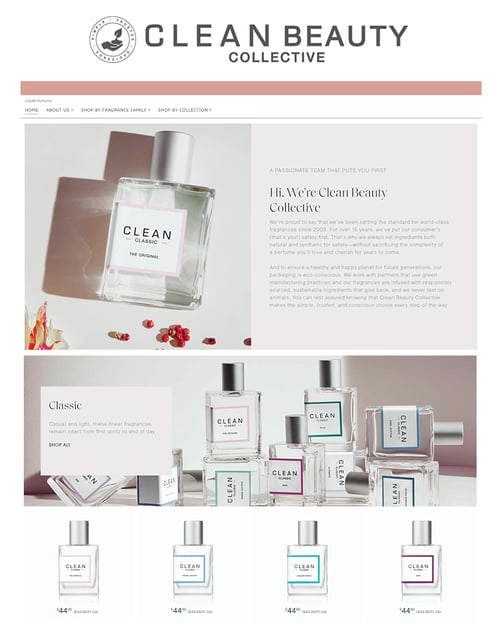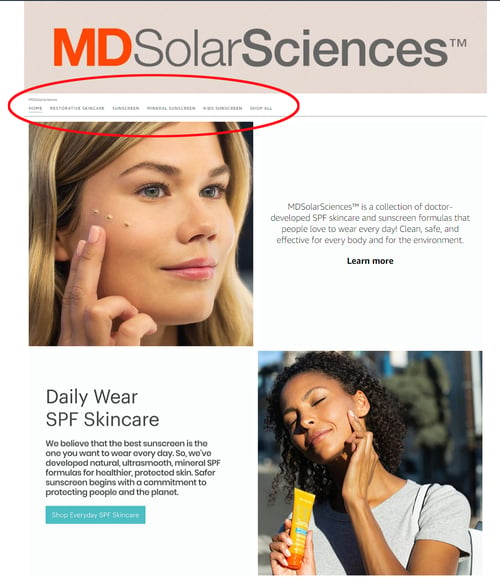In May, I published a piece on the long-lasting benefits of optimizing content on Amazon. That blog post included a high-level overview of beneficial optimizations that may be applied to an Amazon Store, based on my day-to-day work improving our clients’ businesses on Amazon. Lately, Amazon has been testing redirecting traffic from brand product pages to brand Stores, emphasizing their goal of prioritizing brand Stores. This move promotes sellers’ ability to highlight their entire collection on the platform. Amazon Stores are the main way that brands can translate their unique digital experience to Amazon and will be increasingly important on the go-forward. At Stella Rising, we recommend five main ways to deliver a successful, functional Amazon Store, and detail them here with context.
WHAT DO THESE TESTS LOOK LIKE?As an example of how Amazon is testing the Store redirects, first notice this image:
This “Visit the Store” call to action on product display pages is new; compare it with the prior standard brand name which links to the store:

What seems like a minor tweak will have major consequences; with that understanding, we proceed to our focus on improving brand Stores.
HOW TO CREATE A SUPERIOR STORE EXPERIENCE
- Engaging Content: The Store should represent the brand on Amazon through rich, engaging content that continues the experience of their brand website. Amazon’s modules provide a wide variety of options for brands to accurately convey their identity and story. This content should be used to highlight the key differentiators of the brand and their products. The Store’s content should use messaging that aligns with the brand’s tone while also using this content to differentiate the brand from others within the category.

- Taxonomy: Stores should feature a well-designed taxonomy. The top navigation should be structured in a way that is easily understood by the consumer, ideally mirroring the brand’s own website. This can be by category, collections, etc. Methodically categorizing the products enables the consumer to effortlessly navigate the Store, creating a positive customer experience with an increased opportunity of conversion.

- Think Like the Consumer: Proofread and view your Store as if you are a consumer. Errors, including misspellings and off-brand imagery will likely reduce consumer confidence in the brand. Make sure that all text is on-brand and consistent, while proofreading for any potential errors in spelling and punctuation. In addition to text, brands should ensure that all featured images complement the collections and messages being promoted. Errors within the Store may deter consumers from converting, as their trust and interest in the brand diminishes.
- Mobile-Ready: Consumers shop on a variety of devices. A brand’s Store should adapt to meet consumers where they are and offer strong UX despite device. When selecting the text and imagery for a Store, verify that both are optimized for consumers across desktop and mobile. As images and text size may vary across devices, brands need to ensure that they are providing a consistent, functional experience to their consumers.
- Drive Traffic: Once the Store is built, driving traffic is an imperative next step.
-
- From an organic perspective, as previously mentioned, Amazon has been testing their “Visit the Store” call to action on product display pages to make Stores more apparent to consumers. In Luxury Beauty, the brand’s logo also leads to the Brand Store. Pay attention to all organic instances that could drive to brand Store.
- From a paid perspective, brands can drive traffic to their Store from a Sponsored Brand placement, allowing them to feature their entire collection.

- Brands are also able to drive external traffic to their Amazon Store. Amazon allows brands to easily update their Store URL to a more consumer-friendly vanity URL. Brands can place this vanity URL a variety of places, including on social media and Google, providing consumers direct access to their products on Amazon. Social media channels are an excellent place to drive external traffic to Amazon from because once the consumer interacts with the brand on social media, they are then able to be immediately directed to the Store.
A brand’s Amazon Store is the only place on Amazon that shows consumers a brand’s full assortment, allowing for cross-selling and increased basket size opportunities. The Store should reflect a brand’s mission through consistent messaging and accurate, engaging content. A functional, analyzed, and easy-to-navigate Store aids in building brand trust and awareness with the consumer. As the Amazon landscape continues to evolve, Stores increasing play a critical role in how consumers discover and interact with brands on Amazon.



COMMENTS